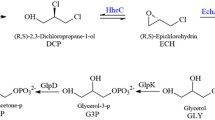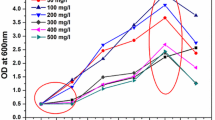Abstract
The long-term performance and stability of Pseudomonas putida mt-2 cultures, a toluene-sensitive strain harboring the genes responsible for toluene biodegradation in the archetypal plasmid pWW0, was investigated in a chemostat bioreactor functioning under real case operating conditions. The process was operated at a dilution rate of 0.1 h−1 under toluene loading rates of 259 ± 23 and 801 ± 78 g m−3 h−1 (inlet toluene concentrations of 3.5 and 10.9 g m−3, respectively). Despite the deleterious effects of toluene and its degradation intermediates, the phenotype of this sensitive P. putida culture rapidly recovered from a 95% Tol− population at day 4 to approx. 100% Tol+ cells from day 13 onward, sustaining elimination capacities of 232 ± 10 g m−3 h−1 at 3.5 g Tol m−3 and 377 ± 13 g m−3 h−1 at 10.9 g Tol m−3, which were comparable to those achieved by highly tolerant strains such as P. putida DOT T1E and P. putida F1 under identical experimental conditions. Only one type of Tol− variant, harboring a TOL-like plasmid with a 38.5 kb deletion (containing the upper and meta operons for toluene biodegradation), was identified.




Similar content being viewed by others
References
Abril MA, Michán C, Timmis KN, Ramos JL (1989) Regulator and enzyme specificities of the TOL plasmid-encoded upper pathway for degradation of aromatic hydrocarbons and expansion of the substrate range of the pathway. J Bacteriol 171:6782–6790.
Birnboim HL, Doly J (1979) A rapid alkaline extraction procedure for screening of recombinant plasmid DNA. Nucleic Acids Res 7:1513–1523
Brinkmann U, Ramos JL, Reinkee W (1994) Loss of the Tol meta-cleavage pathway functions of Pseudomonas putida strain PaW1 (pWW0) during growth on toluene. J Basic Microbiol 34(5):303–309
Bordel S, Diaz LF, Muñoz R, Villaverde S (2007) New insights on toluene biodegradation by Pseudomonas putida F1: Influence of pollutant concentration and excreted metabolites. Appl Microbiol Biotechnol 74:857–866
Díaz LF, Muñoz R, Bordel S, Villaverde S (2008) Toluene biodegradation by Pseudomonas putida F1: targeting culture stability in long term operation. Biodegradation 19:198–207
Duetz WA, van Andel JG (1991) Stability of TOL plasmid pWW0 in Pseudomonas putida mt-2 under non-selective conditions in continuous culture. J Gen Microbiol 137:1369–1374
Harayama S, Leppik RA, Rekik M, Mermod N, Lehrbach PR, Reineke W, Timmis KN (1986) Gene order of the TOL catabolic plasmid upper pathway operon and oxidation of both toluene and benzyl alcohol by the xylA product. J Bacteriol 167:455–461
Hernandez M, Gouveia J, Segura A, Muñoz R, Villaverde S (2008) Addressing the role of the extrusion pump-bearing pGRT1 plasmid on toluene biodegradation by Pseudomonas putida DOT-T1E under real case scenarios. Process Biochemistry (submitted for publication)
Leddy MB, Phipps DW, Ridgway HF (1995) Catabolite-mediated mutations in alternate toluene degradative pathways in Pseudomonas putida. J Bacteriol 177(16):4713–4720
Meulien P, Downing RG, Broda P (1981) Excision of the 40 Kb segment of the TOL plasmid from Pseudomonas putida mt-2 involves direct repeats. Mol Gen Genet 184:97–101
Mosqueda G, Ramos-Gonzalez MI, Ramos JL (1999) Toluene metabolism by the solvent-tolerant Pseudomonas putida DOT-T1 strain, and its role in solvent impermeabilization. Gene 232:69–76
Muñoz R, Díaz LF, Bordel S, Villaverde S (2008) Response of Pseudomonas putida F1 cultures to fluctuating toluene loads and operational failures in suspended growth bioreactors. Biodegradation 19:897–9085
Nakazawa T, Yokota T (1973) Benzoate metabolism in Pseudomonas putida (arvilla) mt-2: demonstration of two benzoate pathways. J Bacteriol 115:262–275
Ramos JL, Marques S, Timmis K (1997) Transcriptional control of the Pseudomonas TOL plasmid catabolic operons is achieved through an interplay of host factors and plasmid-encoded regulators. Annu Rev Microbiol 51:341–372
Ramos JL, Duque E, Gallegos MT, Godoy P, Ramos-Gonzalez MI, Rojas A, Terán W, Segura A (2002) Mechanisms of solvent tolerance in gram-negative bacteria. Annu Rev Microbiol 56:743–768
Revah S, Morgan-Sagastume JM (2005) Methods for odor and VOC control. In: Shareefdeen Z, Singh A (eds) Biotechnology for odour and air pollution. Springer, Heidelberg, pp 29–64
Segura A, Duque E, Mosqueda G, Ramos JL, Junker F (1999) Multiple responses of Gram-negative bacteria to organic solvents. Environ Microbiol 1:191–198
Segura A, Rojas A, Hurtado A, Huertas MJ, Ramos JL (2003) Comparative genomic analysis of solvent extrusion pumps in Pseudomonas strains exhibiting different degrees of solvent tolerance. Extremophiles 7:371–376
Shareefdeen Z, Singh A (2005) Biotechnology for odour and air pollution. Springer, Heidelberg
Sikkema J, de Bont JAM, Poolman B (1995) Mechanisms of membrane toxicity of hydrocarbons. Microbiol Rev 59:201–222
Song JH, Kinney KA (2005) Microbial response and elimination capacity in biofilters subjected to high toluene loadings. Appl Microbiol Biotechnol 68:554–559
U.S. EPA (1994) Ranking of pollutants with respect to human health. Technical background document to support rulemaking pursuant to clean air. Act. section 112 (g). US Environment Protection Agency, Research Triangle Park, N.C.
van Groenestijn JW, Kraakman NJR (2005) Recent developments in biological waste gas purification in Europe. Chem Eng J 113:85–91
Villaverde S, Fernandez MT (1997) Non toluene-associated respiration in a Pseudomonas putida 54G biofilm grown on toluene in a flat-plate vapor-phase bioreactor. Appl Microbiol Biotechnol 48:357–362
Villaverde S, Mirpuri RG, Lewandowski Z, Jones WL (1997) Physiological and chemical gradients in a Pseudomomas putida 54G biofilm degrading toluene in a flat plate vapor phase bioreactor. Biotechnol Bioeng 56:361–371
Williams PA, Murray K (1974) Metabolism of benzoate and the methylbenzoates by Pseudomonas arvilla (arvilla) mt-2: evidence for the existence of a TOL plasmid. J Bacteriol 120:416–423
Williams PA, Taylor SD, Gibb LE (1988) Loss of the toluene-xylene catabolic genes of TOL plasmid pWW0 during growth of Pseudomonas putida on benzoate is due to a selective growth advantage of “cured” segregants. J Gen Microbiol 134:2039–2048
Zilli M, Del Borghi A, Converti A (2000) Toluene removal vapor in a laboratory-scale biofilter. Appl Microbiol Biotechnol 54:248–254
Acknowledgments
This research was supported by the Spanish Ministry of Education and Science (RYC-2007-01667, PPQ2006-08230, CONSOLIDER-C BIO2006 05668, and CONSOLIDER-CSD 2007-00055). Araceli Crespo and Isabel Jimenez are also gratefully acknowledged for their practical assistance.
Author information
Authors and Affiliations
Corresponding author
Rights and permissions
About this article
Cite this article
Muñoz, R., Hernández, M., Segura, A. et al. Continuous cultures of Pseudomonas putida mt-2 overcome catabolic function loss under real case operating conditions. Appl Microbiol Biotechnol 83, 189–198 (2009). https://doi.org/10.1007/s00253-009-1928-5
Received:
Revised:
Accepted:
Published:
Issue Date:
DOI: https://doi.org/10.1007/s00253-009-1928-5




